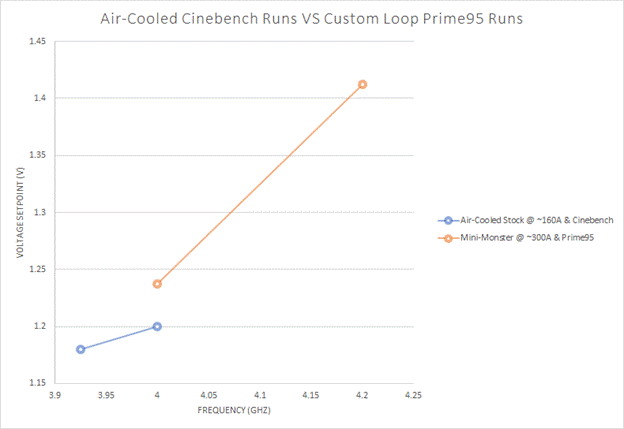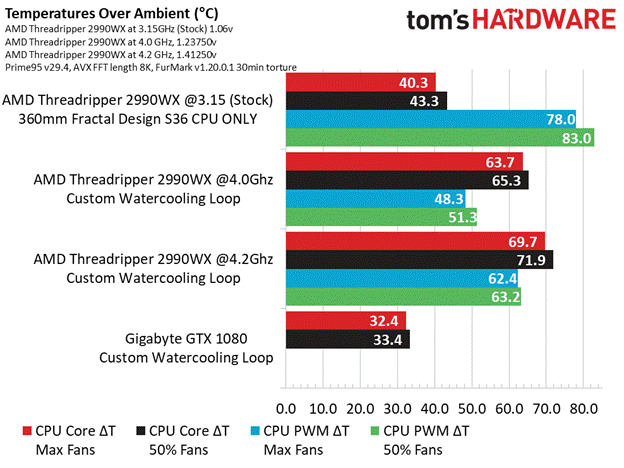Building a Compact Monster PC: Threadripper Meets Micro-ATX and Custom Liquid Cooling
Testing Results and Conclusion
Test System Configuration
| Pump/Reservoir | EK-XRES 100 DDC 3.2 PWM Elite pump and reservoir combo |
| CPU Block | Bitspower ASRX399MTX RGB-Nickel block |
| GPU Block | EK-FC1080 GTX G1 |
| Fittings | EK compression fittings and rotary elbows |
| Radiator | CoolStream PE 240 |
| Fans | EK-Vardar EVO RGB 120ER |
| Tubing | EK-DuraClear 3/8”ID and 5/8”OD |
Now, we know what you are all wondering: How well does this massive liquid cooling build manage temperature regulation on a 32-core Threadripper running at 4.0Ghz with a vCore of 1.23750v? Better yet, how about pushing that overclock even further, up to 4.2Ghz at 1.41250v? Well, here are the charts to answer those very questions:
Referencing the original ASRock X399M motherboard review, we know not much headroom was available for boosting above the 3.15GHz stock boost point before we started hitting thermal throttling events causing the clock to drop down to 550MHz. Disabling many safety features and tweaking the UEFI, 3.25GHz was obtainable for very short, 20 minute intervals with Prime95 pumping through the processor. Clearly acceptable, but we can do better--precisely thanks to our custom cooling loop and its ability to keep the VReg temps tamed.
With all 32 cores of 2990WX Threadripper overclocked by an entire 1.0 GHz (an increase of 1.2 GHz over stock speeds) our wattage load undergoes transformation from simple, consumer electrical power into high-end workstation computing power as it courses through the veins of this system. The largest consumer CPU boasting the highest available core count is now a sprinting mammoth silicon wafer of HEDT (high-end desktop) processing power.
We were able to push the CPU to 4.3Ghz, but struggled to maintain stability over 1 hour of Prime95 stress loading. This might be possible with an updated BIOS on the ASRock X399M Taichi and some additional adjustment, but the higher voltage and clock speeds meant higher load temperatures. Keep in mind, this is running a worst case power workload on the largest consumer chip available.


Let’s put on our speculation hats for a minute. In blue on the charts above, we see our overclocking results for Cinebench with our air-cooled 2990WX with the ASRock X399M Taichi drawing roughly 161A of current as reported by HWiNFO. In orange, Prime95 data with our voltage and frequency setpoints pull approximately ~300A-350A of current. What this means to us is we can draw nearly twice as much current from this regulator and cooling combination as compared to the stock solution. That is impressive. We expect to see 4.3, 4.4, or even 4.5GHz Cinebench runs with this setup, so let us know in the comments if you want to see that happen.
Our EKWB-based cooling system and Bitspower monoblock kept temps well in check during extreme stress testing, with only minimal differences of full- and half-speed fan settings. Motherboard power delivery subcomponents are also blanketed by the Bitspower monoblock, which helps system stability. Even our Gigabyte GTX 1080 remains ultra-cool while running 30-minute runs of FurMark torture tests.
Radiator fan speeds provide us with the cooling potential needed to expel high volumes of heat out of the EK radiators while the EK-XRES 100 DDC 3.2 PWM Elite motivates coolant through the tubing routes at a substantially high flow rate, which is exceptional for such a compact liquid cooling pump.
Get Tom's Hardware's best news and in-depth reviews, straight to your inbox.
Even while approaching 2200 maximum RPM, the EK Vardar fans on our radiators remain relatively quiet in terms of a high-end, multi-radiator liquid cooling system.
So, combining ASRock’s Micro-ATX X399M board and AMD’s top-end Threadripper CPU with adequate custom cooling (ours came from EKWB and Bitspower and performed impressively), it’s clear you can take today’s high-end desktop parts to another level of performance, without the need for a massive case or even annoying levels of fan noise.
Of course, all this says nothing about the costs of getting to this point or how interesting your electric bill might become if you turn a rig like this into a 24/7 rendering rig. Keep in mind that, while we didn’t record exact power numbers over time, when overclocked and under load, our little monster build often pulled more than 800 watts from the wall, according to our Kill A Watt meter. But if you know enough to know you need (or really want) a rig like this, you’re probably aware of these cooling and power considerations.
Liquid cooling or not, it’s clear that AMD’s flagship 2990WX Threadripper processor needs some serious cooling considerations if you plan to turn up the dial on clock speeds, especially in the voltage regulator department. If you really need those 32 cores and 64 threads, paying close attention to this chip’s extra cooling needs is key.
But if you can get by with “just” 32 compute threads and 16 physical cores, AMD’s Ryzen Threadripper 2950X is still our favorite all-around HEDT processor, with lesser cooling requirements. It’s also comparatively affordable at $899. And while it may not be the most impressive performer on the block, if you drop one into a system like this and overclock it to the edge, it would still easily qualify as a mini monster PC.
MORE: Best CPU Cooling
MORE: How To Choose A CPU Cooler
MORE: All Cooling Content

Garrett Carver is a contributor for Tom’s Hardware, primarily covering thermal compound comparisons and CPU cooling reviews; both air and liquid, including multiple variations of each.


